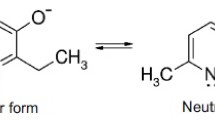Abstract
Morestan (6-methyl-2,3-quinoxalinedithiol cyclic-S,S carbonate) and two of its metabolites: methyl-2,3-quinoxalinedithiol and 6-methyl-2,3-quinoxalinedihydroxy were administered to male and female rats by intraperitoneal route for 4 consecutive days (50 mg/ kg/daily). Morestan was also administered by esophageal intubation for 4 days at the dose of 75 mg/kg/daily. After evaluating the pentobarbital sleeping time in the animals on the 5th day, aminopyrineN-demethylase,p-nitroanisoleO-demethylase and aromatic aniline hydroxylase activities and levels of cytochrome P450, proteins and RNA were measured in the microsomal hepatic fraction. Protein and nucleic acid levels were also measured in whole liver. The 3 substances studied caused considerable decreases in activity of certain microsomal enzymes: morestan inhibits some hepatic mixed-function oxidase systems; in females it is more active by peroral administration, and in males by intraperitoneal route. However, 6-methyl-2,3-quinoxalinedithiol is an even more powerful inhibitor of monooxygenase activities both in males and females. 6-methyl-2,3-quinoxalinedihydroxy also decreases activity by microsomal enzymes, but its action is inferior to that of the other two products investigated.
Similar content being viewed by others
References
Anderson, C. A.: Morestan. Anal. Methods Pestic. Plant Growth Regul., Foods Additives5, 277 (1967).
Anonymous: Evaluations de quelques résidus de pesticides dans les denrées alimentaires—1968, pp. 282. MonographieFAO-OMS Genève (1971).
Carlson, G. P., and K. P. Du Bois: Studies on the toxicity and biochemical mechanism of action of 6-methyl-2,3-quinoxaline-dithiol cyclic carbonate (Morestan). J. Pharmacol. Exp. Ther.173, 60 (1970).
Conney, A. H.: Pharmacological implications of microsomal enzyme induction. Pharmacol. Rev.19, 317 (1967).
Fouts, J. R.: The stimulation and inhibition of hepatic microsomal drug-metabolizing enzymes with special references to effects of environmental contaminants. Toxicol. Appl. Pharmacol.17, 804 (1970).
Gillette, J. R.: Factors affecting drug metabolism. Ann. N. Y. Acad. Sci.179, 43 (1971).
Grewe, F., and H. Kaspers: Le Morestan, un nouveau fongicide du groupe des quinoxalines 2,3-disubstituées, pour la lutte contre l'oÏdium. Bayer Pflschutz-Nachr.18, 1 (1965).
Kato, R., and J. R. Gillette: Effect of starvation on NADPH-dependent enzymes in liver microsomes of male and female rats. J. Pharmacol. Exp. Ther.150, 279 (1965).
Kramer, M., and E. Arrigoni-Martelli: Die VerstÄrkung des narkotischen. Effekts und die Abbauhemmung von Hexobarbital durch Malonsaurederivate. Arch. Exp. Pathol. Pharmakol.237, 264 (1959).
La Du, B. N., L. Gaudette, N. Trousof, and B. B. Brodie: Enzymatic dealkylation of aminopyrine (pyramidon) and other alkylamines. J. Biol. Chem.214, 741 (1955).
Le Duc, E. H.: Regeneration of liver, In: The Liver, Vol. II, New-York: Academic Press (1964).
Martin, T. J.: Morestan, a fungicide and acaricide of the quinoxaline group. Agr. Vet. Chem.4, 156 (1963).
Netter, K. J., and S. Jenner: über die Rolle von Sulfhydrylgruppen bei der mikrosomalen Arzneimittelldemethylierung. Arch. Pharmakol. Exptl. Pathol.255, 120 (1966).
Omura, T., and R. Sato: The carbon monoxide-binding pigment of liver microsomes. I. Evidence for its hemoprotein nature. J. Biol. Chem.239, 2370 (1964).
Paul, J.: Cells and Tissue Culture. 2 ed. Edinburgh: E. S. Livingstone Limited (1961).
Sasse, K., R. Wegler, G. Unterstenhöfer, and F. Grewe: 2.3-Disubstituierte Chinoxaline, eine Gruppe neuer Pflanzenschutzmittel. Angew. Chem.72, 973 (1960).
Schenkman, J. B., I. Frey, H. Remmer, and R. W. Estabrook: Sex differences in drug metabolism by rat liver microsomes. Mol. Pharmacol.3, 516 (1967).
Wannemacher, R. W., Jr., W. L. Banks, Jr., and W. H. Wunner: Use of a single tissue extract to determine cellular protein and nucleic acid concentrations and rate of amino acid incorporation. Analyt. Biochem.11, 320 (1965).
Author information
Authors and Affiliations
Additional information
This work was undertaken with financial aid from the Ministry for the Protection of Nature and Environment: research contract No. 73-61 (139)
Rights and permissions
About this article
Cite this article
Gaillard, D., Chamoiseau, G. & Derache, R. Effect of morestan and other substituted quinoxalines on the activities of various rat hepatic mixed-function oxidases. Arch. Environ. Contam. Toxicol. 5, 403–413 (1977). https://doi.org/10.1007/BF02220920
Issue Date:
DOI: https://doi.org/10.1007/BF02220920



